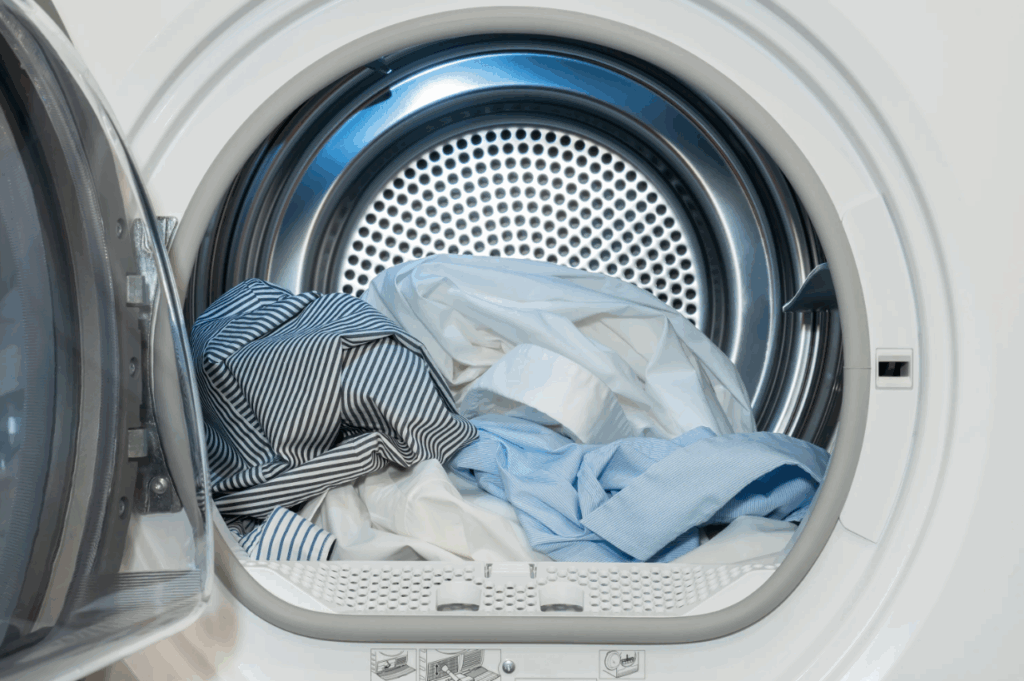Dryers are a major part of modern homes. They help us dry clothes quickly and easily, especially during the winter or rainy seasons. But have you ever wondered how hot does a dryer get when it’s running? Understanding dryer temperatures can help you use your appliance safely and efficiently. It also helps you prevent common problems like shrinking clothes, fire risks, or overheating.
In this blog, we will explain the average temperature of dryers, how different settings affect heat levels, safety concerns, and tips for better performance. Let’s get started with the basics.
How Does a Dryer Work?
Dryers use a combination of heat, airflow, and tumbling to dry clothes. When you start the dryer, air is pulled in from outside, heated by an electric element or gas burner, and blown into the drum. The drum turns slowly, allowing clothes to move freely and dry evenly.
The heated air evaporates moisture from the clothes, and the moist air is pushed out through a vent. This cycle continues until the clothes are dry or the timer ends.
Dryers come with different heat settings, such as:
- Low heat (delicate)
- Medium heat (casual)
- High heat (heavy-duty)
Each of these settings reaches a different temperature range.
What Is the Average Temperature of a Dryer?
Dryers do not all run at the same temperature. The heat level depends on the model, brand, and type of dryer you have. However, most household dryers operate within a certain range.
Electric and gas dryers typically reach these temperatures:
- Low heat: 125°F to 135°F (52°C to 57°C)
- Medium heat: 135°F to 145°F (57°C to 63°C)
- High heat: 150°F to 165°F (66°C to 74°C)
These numbers show that the dryer can get quite hot, especially on high heat settings. This is hot enough to dry heavy loads quickly but still safe when used correctly.
So if you’re asking, how hot does a dryer get, the simple answer is: up to 165°F (74°C) on high heat.
Gas Dryer vs. Electric Dryer: Is There a Difference in Heat?
Both gas and electric dryers are made to perform the same job, but they produce heat differently.
Electric dryers use a heating element, which works like the coil in an electric oven. It takes a bit more time to heat up but maintains a steady temperature.
Gas dryers use natural gas or propane to heat the air. These dryers heat up quickly and often reach higher temperatures faster.
In general, the maximum temperature in both types is nearly the same—about 150°F to 165°F. However, the heating pattern and speed may vary slightly, which can affect drying times.
Why Does Dryer Temperature Matter?
Dryer temperature isn’t just a number—it has a big impact on:
- Clothing safety: Too much heat can shrink or damage fabrics.
- Energy use: Higher heat uses more power or gas.
- Fire safety: Overheating can become a fire hazard.
- Dryer lifespan: Running on high heat constantly can wear out parts faster.
That’s why many dryers come with automatic sensors and settings to manage temperature smartly. Choosing the right temperature for the type of clothes you’re drying is key to getting the best results without wasting energy or damaging anything.
Can a Dryer Overheat?
Yes, a dryer can overheat—and when it does, it becomes dangerous. Blocked vents, clogged lint filters, or broken thermostats can cause dryers to get hotter than they should. Overheating can:
- Damage clothes
- Break internal parts
- Cause fires (lint is highly flammable)
It’s important to clean your dryer’s lint trap after every load and check the exhaust vent regularly. This keeps air flowing freely and avoids unsafe temperatures.
If your dryer feels too hot to touch, shuts down suddenly, or has a burning smell, stop using it and call a repair professional immediately.
How to Check Dryer Temperature at Home
If you’re concerned about how hot your dryer is getting, there’s a simple way to check.
You can buy an oven thermometer or infrared thermometer and place it inside the dryer drum (with the dryer off first). Start a drying cycle on high heat and monitor the temperature after a few minutes.
This can help you confirm if your dryer is working within the normal temperature range. If it’s going beyond 165°F or staying too low, it may need service or cleaning.
Knowing how hot does a dryer get with actual testing helps ensure your appliance is running safely.
Tips to Use Dryer Heat Settings the Right Way
Using the correct heat setting is essential for taking care of your clothes and your appliance. Here’s a quick guide:
1. Low Heat (Delicates, Lingerie, Activewear)
- Great for synthetic fabrics, spandex, and lightweight clothing.
- Prevents damage to fragile materials.
2. Medium Heat (Everyday Clothes)
- Suitable for t-shirts, jeans, and cotton blends.
- Balances drying time with fabric care.
3. High Heat (Towels, Bedding, Heavy Clothes)
- Best for thick items like blankets, jackets, and towels.
- Speeds up drying but should be used cautiously.
When in doubt, go for lower heat. It may take a little longer, but it protects your clothes and avoids unnecessary wear on your dryer.
How to Keep Your Dryer from Getting Too Hot
Here are a few simple maintenance tips to make sure your dryer stays within safe temperature limits:
- Clean the lint filter after every load.
- Check the dryer vent every 3–6 months. Make sure it’s not blocked.
- Avoid overloading the dryer. It makes the motor work harder and can trap heat.
- Use the correct drying cycle. Don’t use high heat for delicate items.
- Have your dryer serviced yearly. A technician can inspect and clean internal parts.
Regular care will keep your dryer running efficiently and prevent temperature issues.
Final Thoughts
So, how hot does a dryer get? Most dryers operate between 125°F and 165°F, depending on the settings you choose and the type of machine you have. While these temperatures are safe for drying clothes, it’s important to use the right heat levels, clean your dryer regularly, and monitor performance to avoid overheating.
Using your dryer wisely helps you save energy, protect your clothes, and prevent fire risks. If your dryer is getting too hot or not drying properly, don’t ignore it—get it checked by a professional.
Dryers are one of the most helpful appliances in the home. By understanding how they work and how hot they get, you can make sure yours runs smoothly for years to come.

